Cultural Learning Starts with Curiosity: Why Art, Food, and Film Matter
Learning a language is not only about mastering grammar and memorizing vocabulary—it’s about understanding the culture that shapes its expressions, gestures, and meanings. For students of Italian, engaging with the country’s vibrant art, cuisine, and cinema opens the door to immersive learning that feels both natural and deeply human.
Art introduces students to visual storytelling that complements verbal communication. From Renaissance masterpieces to contemporary design, Italian art offers a language of symbols, emotions, and perspectives that deepens one’s grasp of cultural nuance.
Italian cuisine is equally expressive. Understanding culinary traditions means understanding regional identities, seasonal rhythms, and social rituals. Ordering a plate of pasta becomes a lesson in local dialects, menu terminology, and etiquette.
Cinema brings spoken Italian to life. Watching films exposes students to pronunciation, slang, and emotional tone, while also presenting diverse social realities, historical narratives, and everyday conversations. Whether it’s a Fellini classic or a modern drama, every scene reinforces listening skills and cultural literacy.
At Spaziolingua, cultural immersion is an integral part of how we teach. We integrate visits to museums, cooking labs, and film screenings directly into our language curriculum, ensuring that students engage with Italian not as a subject to be studied, but as a culture to be lived.
Want to explore Italian through art, food, and film? Contact Spaziolingua to discover our cultural immersion programs.
Discovering Language Through Art: A Visual Gateway to Expression
Art is often described as a universal language—but when paired with the spoken word, it becomes a powerful tool for linguistic and cultural discovery. For students of Italian, engaging with Italy’s immense artistic heritage offers a unique pathway to learning. From frescoes in Florence to street art in Milan, visual culture becomes a springboard for conversation, vocabulary development, and emotional engagement.
In museums and galleries, students encounter not just beautiful works, but opportunities to describe, interpret, and analyze in Italian.
Asking “Cosa rappresenta questo dipinto?” (What does this painting represent?) or “Qual è il significato di questo colore?” (What’s the meaning of this color?) stimulates dialogue and enriches expressive capacity. Art encourages learners to move beyond functional language and embrace opinion, feeling, and metaphor.
Additionally, studying art history in Italian introduces technical vocabulary—terms like affresco, prospettiva, scultura—which add depth and specificity to one’s language skills. These specialized words become part of a learner’s toolkit, especially useful for students interested in academic or cultural careers.
At Spaziolingua, we incorporate art-focused activities in our courses. Students participate in guided visits to museums like the Pinacoteca di Brera or the Uffizi, followed by classroom discussions entirely in Italian. These immersive moments help students connect emotionally with the language, while also improving their descriptive fluency, listening comprehension, and speaking confidence.
By interpreting visual narratives, students also learn to understand the Italian worldview—its relationship to beauty, symbolism, and history. The result is a richer, more nuanced form of language acquisition that fosters personal insight and cultural empathy.
Interested in exploring Italian through masterpieces and murals? Contact Spaziolingua to join our art-integrated language experiences.
The Language of Food: How Italian Cuisine Teaches More Than Recipes
Italian cuisine is one of the most beloved in the world—but for language learners, it offers more than just delicious meals. Food is a living expression of Italian identity, and exploring its vocabulary, rituals, and regional diversity provides an immersive linguistic experience that is rich, engaging, and unforgettable.
Every dish tells a story. When a student learns that “carbonara” originates from Lazio or that “arancini” are a Sicilian specialty, they are also learning about geography, history, and local dialects. Asking “Quali ingredienti ci sono?” (What ingredients are there?) or “È una ricetta tradizionale?” (Is it a traditional recipe?) encourages conversation that goes beyond the plate. These dialogues are packed with practical vocabulary—ingredients, cooking verbs, expressions of taste and preference.
At Spaziolingua, we turn this sensory engagement into a learning opportunity. Our students participate in hands-on cooking workshops, guided by native-speaking chefs. These sessions are conducted in Italian, allowing learners to hear and use the language while preparing pasta from scratch, selecting seasonal produce, or learning the nuances of Italian table etiquette.
Dining out also becomes an educational moment. Reading menus, ordering confidently, understanding regional terminology—these are real-life skills that reinforce both linguistic accuracy and cultural competence. Even learning when and how to say “Buon appetito”, or how to politely ask for the bill, helps students internalize the unspoken codes of Italian social life.
Culinary immersion isn’t just about food—it’s about building connections through shared experience. When language is tied to taste, smell, and laughter around the table, it becomes memorable, meaningful, and alive.
Want to practice your Italian while savoring its flavors? Contact Spaziolingua to join our language-through-cuisine programs.

Italian Cinema: Listening, Feeling, and Speaking Through Film
Few tools are as effective—and as enjoyable—for language learners as cinema. Italian film opens a window into the soul of the language, offering students the chance to hear authentic speech, absorb cultural references, and connect emotionally with stories told in the voices of native speakers. Watching movies isn’t just entertainment—it’s education in action.
Unlike classroom dialogues or scripted textbook exercises, Italian cinema reflects natural rhythms of conversation. Viewers are exposed to regional accents, idiomatic expressions, tone shifts, and body language—all vital for real-life communication. Films like La Vita è Bella, Il Postino, or Perfetti Sconosciuti showcase not only the language, but also how it’s infused with humor, emotion, irony, and intensity.
For learners, this exposure is invaluable. Subtitles help bridge comprehension gaps, while repeated viewing of key scenes builds listening stamina and reinforces vocabulary. Phrases like “Che succede?” (What’s happening?) or “Ci vediamo domani” (See you tomorrow) become part of one’s active lexicon simply through contextual repetition.
At Spaziolingua, we integrate cinema into our curriculum with curated film screenings and discussion sessions. After watching a film or specific excerpts, students participate in guided conversations, vocabulary reviews, and cultural analysis—always in Italian. This helps sharpen critical thinking, build speaking confidence, and enhance cultural fluency through media that resonates emotionally.
Italian cinema also introduces learners to social realities, values, and generational perspectives that no grammar book can convey. By engaging with characters and narratives, students not only learn how Italians speak—they discover what they care about, fear, fight for, and laugh at.
Ready to learn Italian through the magic of the screen? Contact Spaziolingua to explore our courses.
Culture-Driven Learning as Personal Transformation
Engaging with a language through its culture doesn’t just make learning more enjoyable—it makes it more personal, profound, and enduring. When students immerse themselves in Italian through art, cuisine, and cinema, they gain more than new vocabulary. They begin to see, feel, and live the world as Italians do. This shift opens the door to a type of fluency that is both linguistic and human.
Cultural immersion allows students to move beyond transactional communication. Instead of asking how to say a specific phrase, they begin to ask, “Why do Italians express it this way?” This curiosity drives deeper learning. It sparks empathy, builds emotional intelligence, and fosters a sense of connection that transcends grammar rules.
The result is not just better Italian—it’s a transformed learner. Someone who no longer fears speaking in public, who navigates ambiguity with confidence, who understands cultural nuances not just intellectually but intuitively. These students begin to interact with the world more mindfully, and their newly acquired language becomes a bridge to community, opportunity, and self-expression.
At Spaziolingua, we believe that culture is not an add-on—it’s the foundation. Our courses are designed to help students discover who they are through what they learn. Whether you’re admiring a Caravaggio, sharing a risotto, or quoting a film scene, each cultural experience becomes a moment of revelation, confidence, and joy.
The journey of learning Italian through culture doesn’t end with a certificate. It continues in every conversation, every cultural encounter, and every reflection. It changes how students see the language—and how they see themselves.
Ready to learn Italian in a way that transforms how you think, speak, and feel? Take our free level test and start your cultural immersion with Spaziolingua today.







